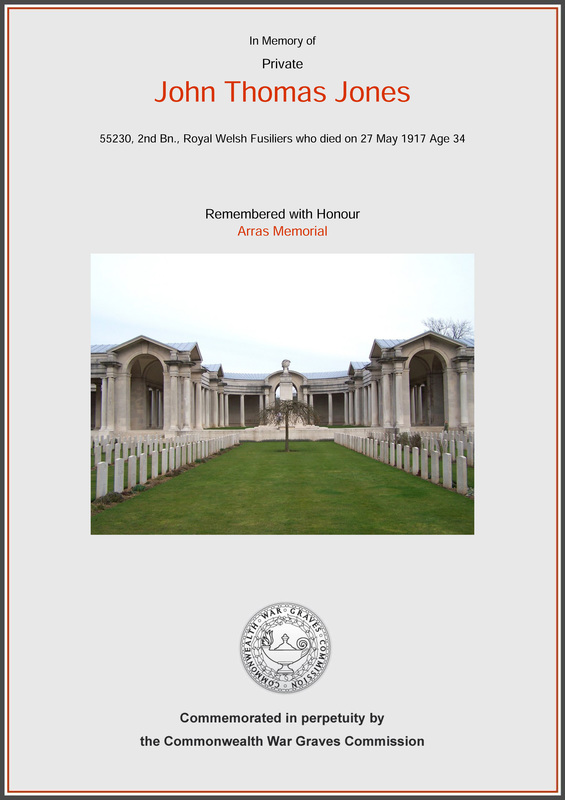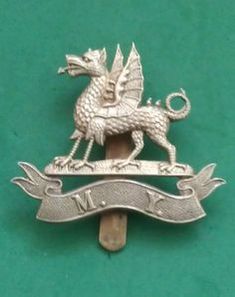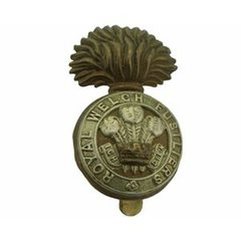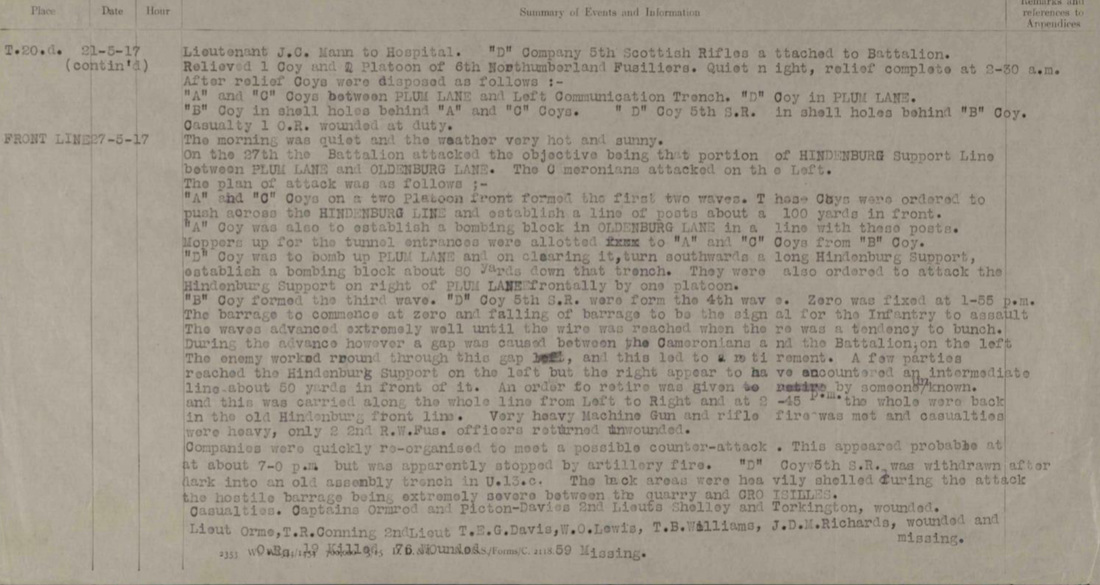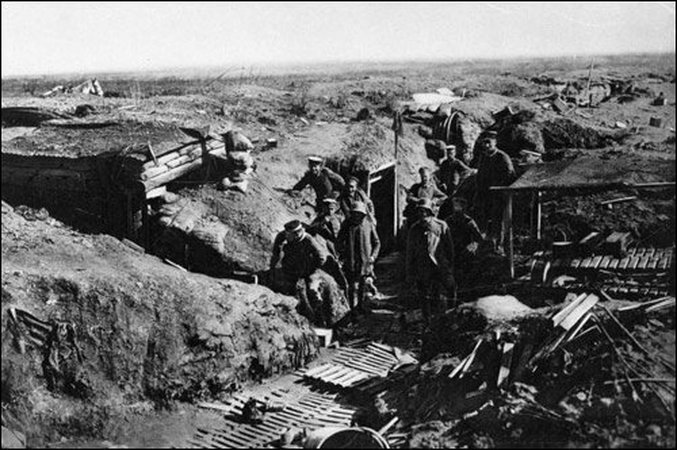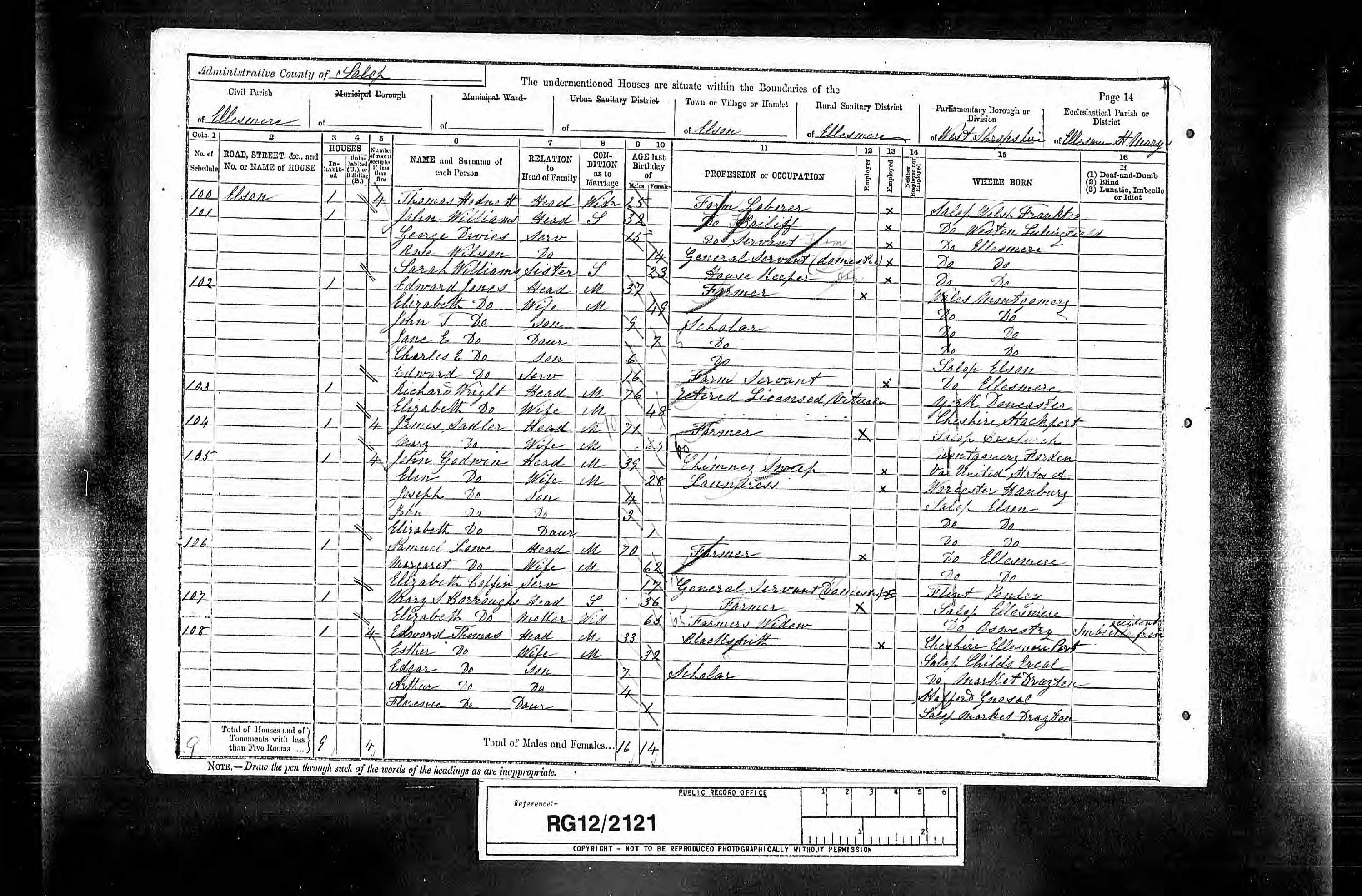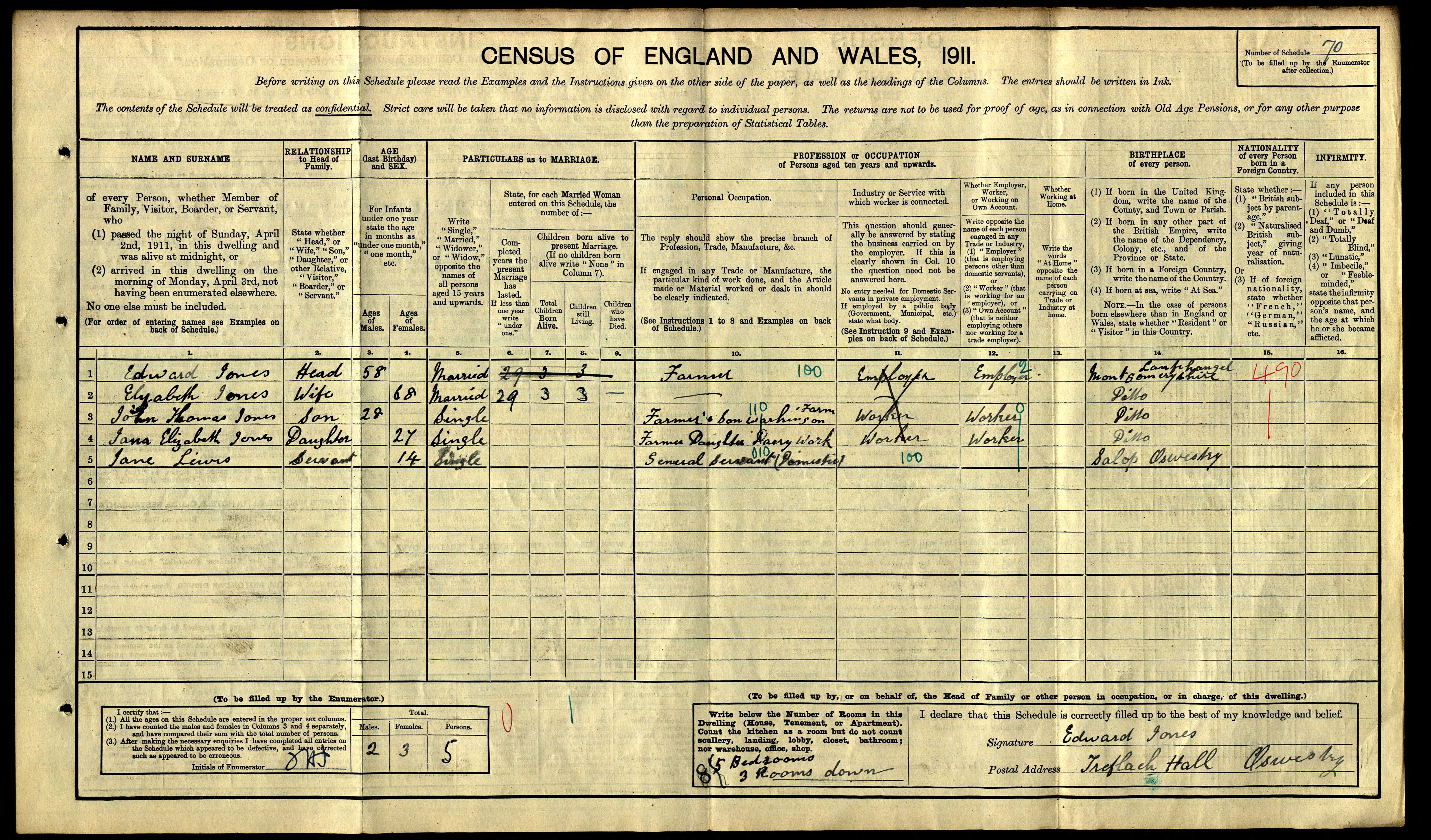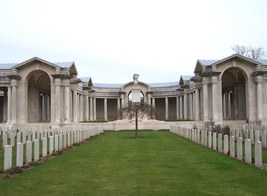John Thomas Jones
|
Introduction
John Thomas Jones was born in 1883 in Elson, Ellesmere along with a younger sister Jane (Ginny) and a younger brother Charles Edward (Charley) His parents Edward and Elizabeth were farmers and by the 1911 census they had moved to Treflach Hall Farm. John Thomas continued to work on the farm up until his enlistment in September 1914. His brother Charley Edward Jones is also represented on this website as he too was to lose his life in the First World War and it is recorded in local history that the loss of the brothers had a huge impact on both the local community and their family. The brother's sister was known locally as Jinny the Pit and an extract from Bernard Martins Jottings (a local man's account of village life in the 30s and 40's) shown below highlights this. |
"Lower down but on the left hand side was Ivy House, a smallholding owned by the Jones family from Treflach Hall; they had tragically lost their two sons in the 1st World War, but had returned to the holding together with their daughter Jinny. Ivy House had originally been connected to the Trefonen Colliery, we knew it as Pit House; the daughter was always known as ‘Jinny the Pitt.’ I think she had been mentally affected by the tragedy that had befallen her brothers and was eccentric to say the least. Her mental decline was so sad: wearing odd shoes, coming into the village wearing an apron, not wearing a skirt, for before my time she had played the organ in chapel. The Jones family were extremely generous to the Congregational Chapel, for they gave the ground on which the Manse was built, also at Miss J Jones’ death, the farm holding was sold and the proceeds given to the chapel.
After the death of the two sons it was thought that the Jones Family sold Treflach Hall Farm in 1918 as they no longer felt they could live in the home where they had raised their family.
After the death of the two sons it was thought that the Jones Family sold Treflach Hall Farm in 1918 as they no longer felt they could live in the home where they had raised their family.
|
Military Record including Regimental and Battalion Information
Private John Thomas Jones 2422 enlisted into the Montgomeryshire Yeomanry in September 1914. It would seem he followed a very similar path during his army days to Thomas John Ellis from Trefonen who I am led to believe was a cousin. Like his cousin he transferred to the Royal Welsh Fusiliers 4th Reserve Battallion in mid November 1916 as number 11822 then on 7th December was sent to France to an Infantry Base Depot. Again like his cousin he was transferred to the front line with the 2nd Battalion Royal Welsh Fusiliers as number 55230 on 13th December 2016. Private John Thomas Jones was killed in action on the 27th May 1917 whilst fighting on the Hindenburg front line near to Croisilles. On that day the 2nd Bn took part in an attack. They met with heavy machine gun and rifle fire. Losses in the ranks were 19 killed, 76 wounded, 59 Missing. The Battallion War Diary for the day is shown below. |
Census data
Historical Information
The French handed over Arras to Commonwealth forces in the spring of 1916 and the system of tunnels upon which the town is built were used and developed in preparation for the major offensive planned for April 1917.
The Commonwealth section of the FAUBOURG D'AMIENS CEMETERY was begun in March 1916, behind the French military cemetery established earlier. It continued to be used by field ambulances and fighting units until November 1918. The cemetery was enlarged after the Armistice when graves were brought in from the battlefields and from two smaller cemeteries in the vicinity.
The cemetery contains over 2,650 Commonwealth burials of the First World War, 10 of which are unidentified. The graves in the French military cemetery were removed after the war to other burial grounds and the land they had occupied was used for the construction of the Arras Memorial and Arras Flying Services Memorial.
The adjacent ARRAS MEMORIAL commemorates almost 35,000 servicemen from the United Kingdom, South Africa and New Zealand who died in the Arras sector between the spring of 1916 and 7 August 1918, the eve of the Advance to Victory, and have no known grave. The most conspicuous events of this period were the Arras offensive of April-May 1917, and the German attack in the spring of 1918. Canadian and Australian servicemen killed in these operations are commemorated by memorials at Vimy and Villers-Bretonneux. A separate memorial remembers those killed in the Battle of Cambrai in 1917.
The adjacent ARRAS FLYING SERVICES MEMORIAL commemorates almost 1,000 airmen of the Royal Naval Air Service, the Royal Flying Corps, and the Royal Air Force, either by attachment from other arms of the forces of the Commonwealth or by original enlistment, who were killed on the whole Western Front and who have no known grave.
During the Second World War, Arras was occupied by United Kingdom forces headquarters until the town was evacuated on 23 May 1940. Arras then remained in German hands until retaken by Commonwealth and Free French forces on 1 September 1944. The 1939-1945 War burials number 8 and comprise 3 soldiers and 4 airmen from the United Kingdom and 1 entirely unidentified casualty. Located between the 2 special memorials of the 1914-1918 War is the special memorial commemorating an officer of the United States Army Air Force, who died during the 1939-1945 War. This special memorial, is inscribed with the words "Believed to be buried in this cemetery". In addition, there are 30 war graves of other nationalities, most of them German.
Both cemetery and memorial were designed by Sir Edwin Lutyens, with sculpture by Sir William Reid Dick. The memorial was unveiled by Lord Trenchard, Marshal of the Royal Air Force on the 31 July 1932 (originally it had been scheduled for 15 May, but due to the sudden death of French President Doumer, as a mark of respect, the ceremony was postponed until July).
click on the link below for more information
http://www.cwgc.org/find-a-cemetery/cemetery/82700/ARRAS%20MEMORIAL
The French handed over Arras to Commonwealth forces in the spring of 1916 and the system of tunnels upon which the town is built were used and developed in preparation for the major offensive planned for April 1917.
The Commonwealth section of the FAUBOURG D'AMIENS CEMETERY was begun in March 1916, behind the French military cemetery established earlier. It continued to be used by field ambulances and fighting units until November 1918. The cemetery was enlarged after the Armistice when graves were brought in from the battlefields and from two smaller cemeteries in the vicinity.
The cemetery contains over 2,650 Commonwealth burials of the First World War, 10 of which are unidentified. The graves in the French military cemetery were removed after the war to other burial grounds and the land they had occupied was used for the construction of the Arras Memorial and Arras Flying Services Memorial.
The adjacent ARRAS MEMORIAL commemorates almost 35,000 servicemen from the United Kingdom, South Africa and New Zealand who died in the Arras sector between the spring of 1916 and 7 August 1918, the eve of the Advance to Victory, and have no known grave. The most conspicuous events of this period were the Arras offensive of April-May 1917, and the German attack in the spring of 1918. Canadian and Australian servicemen killed in these operations are commemorated by memorials at Vimy and Villers-Bretonneux. A separate memorial remembers those killed in the Battle of Cambrai in 1917.
The adjacent ARRAS FLYING SERVICES MEMORIAL commemorates almost 1,000 airmen of the Royal Naval Air Service, the Royal Flying Corps, and the Royal Air Force, either by attachment from other arms of the forces of the Commonwealth or by original enlistment, who were killed on the whole Western Front and who have no known grave.
During the Second World War, Arras was occupied by United Kingdom forces headquarters until the town was evacuated on 23 May 1940. Arras then remained in German hands until retaken by Commonwealth and Free French forces on 1 September 1944. The 1939-1945 War burials number 8 and comprise 3 soldiers and 4 airmen from the United Kingdom and 1 entirely unidentified casualty. Located between the 2 special memorials of the 1914-1918 War is the special memorial commemorating an officer of the United States Army Air Force, who died during the 1939-1945 War. This special memorial, is inscribed with the words "Believed to be buried in this cemetery". In addition, there are 30 war graves of other nationalities, most of them German.
Both cemetery and memorial were designed by Sir Edwin Lutyens, with sculpture by Sir William Reid Dick. The memorial was unveiled by Lord Trenchard, Marshal of the Royal Air Force on the 31 July 1932 (originally it had been scheduled for 15 May, but due to the sudden death of French President Doumer, as a mark of respect, the ceremony was postponed until July).
click on the link below for more information
http://www.cwgc.org/find-a-cemetery/cemetery/82700/ARRAS%20MEMORIAL
